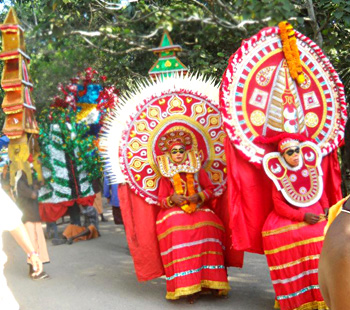 Various festivals are celebrated in the Vaikom Temple of Kerala. The most important festival of the temple is the annual Ashtami Festival. Ashtami Festival is celebrated in the in the month of Vrischikam. It is a 13-day festival, the main event, Ashtami being on the 12th day and arattu or the holy bath for the deity on the 13th. In fact, the Vaikom Ashtami is considered so auspicious that it is observed throughout Kerala with special poojas to Vaikathappan.
Various festivals are celebrated in the Vaikom Temple of Kerala. The most important festival of the temple is the annual Ashtami Festival. Ashtami Festival is celebrated in the in the month of Vrischikam. It is a 13-day festival, the main event, Ashtami being on the 12th day and arattu or the holy bath for the deity on the 13th. In fact, the Vaikom Ashtami is considered so auspicious that it is observed throughout Kerala with special poojas to Vaikathappan.
At the temple on each of the 13 days there are special programmes, poojas and rites, elephant processions, public feeding, music, dance and other entertainments. Thousands from the neighbourhood attend these functions. The celebration reaches its peak on Ashtami Day. The salient features of the Ashtami Day are the early morning darshan, the feast at noon and the procession at night from Udayanapuram. From the early hours of the day, devotees crowd the temple chanting holy names. This is followed by darshan at Udayanapuram about 3 km. to the north of the Vaikom temple, on the Vaikom-Ernakulam road. The presiding deity here is Lord Subramanya, son of Shiva.
The main event of the Ashtami occurs at night when the happy meeting between Vaikathappan and Udayana-purathappan or the Lord of Udayanapuram takes place. It is believed that the son had gone to battle with the asuras and the meeting is an occasion for the father to greet the triumphant son. The coming of Udayanapuram deity with Gods and Goddesses of the neighbouring temples on gorgeously caparisoned elephants accompanied by nadaswaram and hundreds of torches (theevattis) is a spectacular sight.
There are other famous temple processions in Kerala like the Trichur Pooram and the Arattupuzha Pooram in which several elephants participate. But the procession from Udayanapuram is singularly grand and hundreds of thousands gather to witness this symbolic meeting between father and the son.
The Celestial Meeting
 The 2 km. procession from Udayanapuram takes nearly 3 hours to reach the north gate at Viakom at about 1 .30 A.M. During the period the 300 torches consume nearly 100 tins of oil. All the while, Vaikathappan, the father, mounted on the elephant, stands impatiently to meet his beloved son. The meeting takes place at the east nada to the accompaniment of another moving song in praise of Paramasiva.
The 2 km. procession from Udayanapuram takes nearly 3 hours to reach the north gate at Viakom at about 1 .30 A.M. During the period the 300 torches consume nearly 100 tins of oil. All the while, Vaikathappan, the father, mounted on the elephant, stands impatiently to meet his beloved son. The meeting takes place at the east nada to the accompaniment of another moving song in praise of Paramasiva.
Devotees wipe tears of joy from their eyes and offer kanikkai (offering of money) to the deities.
Thereafter father and son take a round of the temple and then the equally touching farewell takes place at the northern gate. The rendering of Khandara or Neelambari ragas lends pathos to the occasion.
Koodi Puja
The next day the holy bath ceremony (arattu) takes place at the tank (arattu kulam) about a kilometre from the east nada. For this function also the Lord of Udayanapuram comes to Vaikom. After the arattu, a koodi (joint) pooja takes place for both father and son in the sanctum. This ritual is again unique and not seen in any other temple in Kerala. There is no more auspicious occasion for the devotees than the koodi puja and naturally they gather in their thousands, with whole families. Annapra-itnam, Thulabharam and various other festivals also take place at this time.
After the ceremony Vaikathappan also goes to the ion`s place and has his holy bath there. There again Koodi pooja takes place. It is significant that on Ashtami day there is no pooja or naivedyam at Vaikom temple. Vaikathappan himself observes a fast, prays for his son`s success in battle, while feeding thousands as an act of penance. The feast on Ashtami day is particularly grand. It is the rule that everybody must be fed sumptuously on this day.
Sandhya Vela
Sandhya Vela is another ritual specially conducted at Vaikom particularly during the 40 days preceding Ashtami. The main ceremony is recital of Vedas by learned Brahmins sitting on the mandapam. Then there are siveli or procession in the morning, of course a feast at noon and vilakku (Laksha deepam) at night.
Different parties like the rulers of Travancore and Cochin, various associations like the Brahmin samooham and neighbouring devaswamis like Ambalapuzha used to vie with one another in the past in celebrating Sandhya Vela.





















